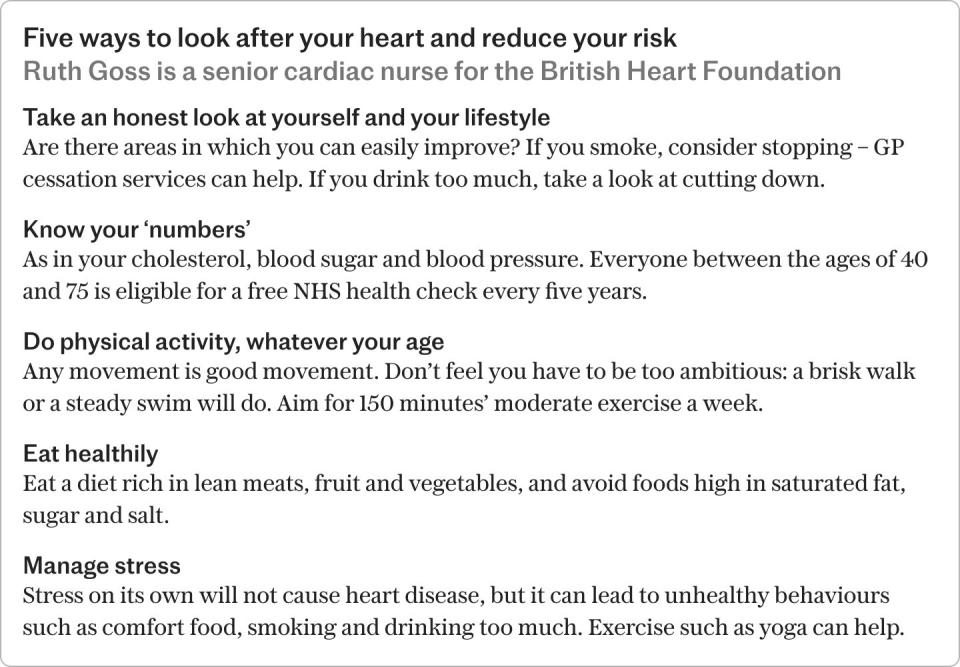The heart health risks for midlife women – and how to beat them

When, in her late 40s, Rebecca Hutchinson started having hot flushes and dizzy spells, she thought it was because of the menopause, and her doctors believed the same. “I started to have episodes where I felt ‘funny’,” she says. “If ever I went for a long walk, I would feel clammy, get out of breath and have to sit down. In a hot tub on my wedding anniversary, my swimming costume felt so tight I thought it was strangling me. It didn’t occur to me this would have anything to do with my heart.”
Hutchinson, who is now 57, was a normal weight, ate healthily and took regular exercise. She consulted her GP several times: on each occasion, she was told: “It’s just your age.” Hutchinson was given hormone replacement therapy (HRT), which helped with some of the symptoms, but not the hot flushes. The reason? Her symptoms were a sign of angina – pain in the chest caused by reduced blood flow to the heart muscles, and a warning sign for risk of a heart attack or stroke.
In December 2018, Hutchinson, who works part-time in her local Apple store in Gosport, had a massive heart attack.

Asked to picture a heart attack victim, most people would imagine a middle-aged, overweight man clutching his chest. However, a body of research reveals that midlife women are increasingly at risk of cardiovascular problems.
It makes a case for more midlife women to be vigilant about their heart health and request relevant tests from their GP to keep an eye on their results. All people aged 40 to 74 will be invited to a five-yearly NHS Health Check. A health professional will measure your blood pressure, cholesterol, height, weight and waist. You will also be asked questions about your lifestyle habits such as smoking, alcohol consumption and exercise routines.
At the end of the consultation, you will be given a ‘QRisk’ score, explaining your risk of a cardiac ‘event’ in the next 10 years. A (low) QRisk score of less than 10 per cent means that you have less than a one in 10 chance of having a stroke or heart attack in the next 10 years and a ‘high’ QRisk score of more than 20 per cent means that you have at least a two in 10 chance of having a stroke or heart attack in the next 10 years. Your doctor will then discuss treatment options with you.
Should you go more often? According to Amitava Banerjee, a professor of clinical data science at University College London and honorary consultant cardiologist at University College London Hospitals and Barts Health NHS Trusts, as long as your NHS health check is satisfactory and you follow your GP’s advice, there is no need to seek further tests.
“An annual health check is not necessary,” he says. “Good health is not about having more tests and seeing more doctors. The most important thing you can do is modify your risks of cardiovascular disease, by not smoking, remaining a healthy weight, eating a good diet, exercising and managing conditions such as diabetes and high blood pressure.”
Last month, a presentation at the American College of Cardiology’s Annual Scientific Session revealed how a woman’s risk of cardiovascular disease can rise sharply after she goes through menopause, quickly catching up to men of a similar age and health profile.
“This unique study signals that post-menopausal women may have a risk of heart disease that is on par with males,” says Ella Ishaaya, an internal medicine physician at Harbor-UCLA Medical Centre. “Women are underscreened and undertreated, especially post-menopausal women, who have a barrage of new risk factors that many are not aware of. This study raises awareness of what those risk factors are and opens the door to indicating the importance of increased screening.”
“Women have a lower incidence of cardiovascular disease early in life, but they do catch up after menopause,” Prof Banerjee explains. “There are a number of reasons for this: early in life men tend to have higher risk factors, such as smoking and heavy drinking. Women were also historically less likely to go to their doctor’s, and if they did, their symptoms would be different; for example, with less central chest pain.”
Women of menopausal age also lose the protective effect of oestrogen. “When women start menopause, they experience changes in their hormone levels that can leave them at higher risk of heart disease,” says Ruth Goss, a senior cardiac nurse at the British Heart Foundation. “Oestrogen protects your heart by helping to control cholesterol levels and making sure that less fat builds up in your arteries. During menopause, the levels of this hormone decrease, making it easier for fatty deposits to build up and narrow blood vessels, which can lead to heart attacks and strokes.”
These biological changes lead to Hutchinson’s eventual heart attack. “After months of ‘funny turns’, I was in bed after a minor operation on my thumb, when I woke up feeling a massive weight on my chest,” she says. “I went in and out of consciousness for three or four hours.” It was only when Hutchinson looked at her smartwatch which showed her heart-rate was fluctuating between 30bpm and 160bpm that she thought she should call 111.
“All the time I was thinking ‘don’t be silly, of course you aren’t having a heart attack’, but the pain in my neck became unbearable,” she says. Ten minutes later, an ambulance showed up.
The hospital technician who took Hutchinson’s electrocardiogram (ECG) also told her she didn’t look like a cardiac patient. “And yet, as soon as the doctors saw the results, they saw how serious it was.” Hutchinson was told she’d had a massive heart attack and had four stents fitted into her arteries. “They later told me they didn’t think I would survive,” she says. Five years on, she now takes a variety of medications including statins and blood thinners, and lives a full and normal life.
Hutchinson’s tale is a cautionary one. “I later found out my heart attack was due to a condition called familial hypercholesterolemia,” she says. “Ten years earlier, I had had a routine blood test, which showed abnormally high levels of ‘bad’ low-density lipoprotein (LDL) cholesterol and low levels of the good, balancing high-density lipoprotein (HDL) cholesterol. Because all my other blood scores were in the normal range, my GP hadn’t told me about this.”
As Hutchinson passed the menopause, her high cholesterol started to cause her angina. If she’d known the truth about her results, her heart attack could have been avoided. “All women need to ask their GPs for their results,” she says. “Don’t be fobbed off when they tell you: ‘you won’t understand them’. Knowing your ‘numbers’ could save your life.”
What should your ‘heart numbers’ be?
Blood pressure
A normal blood pressure reading is when the systolic pressure (upper number) is lower than 120mmHg and the diastolic pressure (lower number) is lower than 80mmHg. When these levels climb to 130mmHg or higher for systolic pressure or 80mmHg or higher for diastolic pressure, this is considered high blood pressure, or hypertension.
Treatment is recommended for women whose blood pressure regularly exceeds these limits. “High blood pressure becomes more common as women age—at least 41 per cent of postmenopausal women and more than 75 per cent of women older than 60 years have hypertension,” says the North American Menopause Society (NAMS).
Cholesterol
Working out an ideal cholesterol level can be tricky as there are many elements to take into account. However, as a rule of thumb, a healthy level of a full-cholesterol level is ideally under five.
“High levels of cholesterol, especially high levels of LDL cholesterol, in the blood can cause a buildup of plaque on the inner walls of arteries,” says NAMS. If the plaque slows blood flow or a blood vessel in the heart becomes blocked, this can lead to a heart attack.
Levels of triglycerides, another component of cholesterol, appear to be a better predictor of heart disease in women than in men, so ask your doctor about these when you have a check.
Blood sugar
People with diabetes are significantly more likely to develop heart disease than those without it. According to the British Heart Foundation, if your HbA1c (which measures your average glucose levels over the past two to three months) is more than 42 mmol/mol or fasting blood glucose is more than 11 mmol/L, your blood sugar is high (prediabetes covers the range 42 to 47: 48 and up is diabetes).
For most people without diabetes, normal blood sugar levels are between 4 and 6mmol/L before a meal and less than 8mmol/L two hours after eating.
Waist-height ratio
“Central obesity”, building up fat around your middle, is linked to high cholesterol, high blood pressure, and diabetes. As a general rule of thumb, your waist measurement should be less than half your height.
“For women, below 80cm (31.5in) is low risk, 80–88cm (31.5-34.6in) is high risk and more than 88cm (34.6in) is very high. These are the guidelines for people of white European, black African, Middle Eastern and mixed origin,” say British Heart Foundation guidelines.

